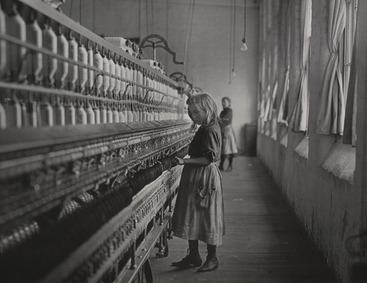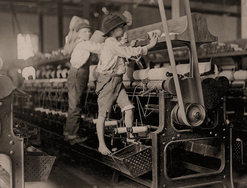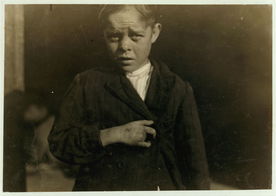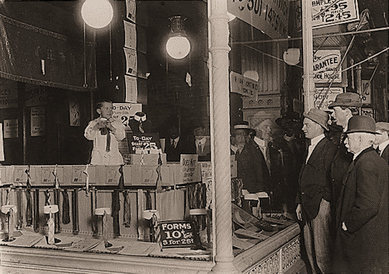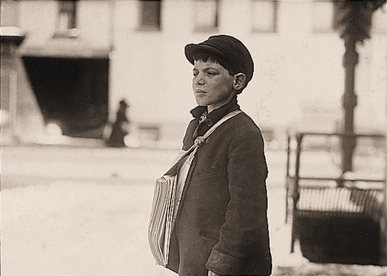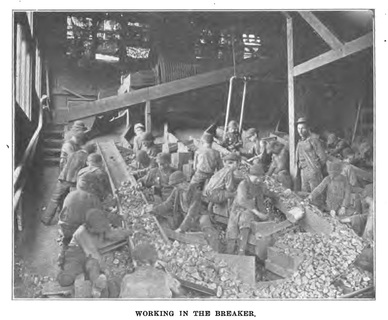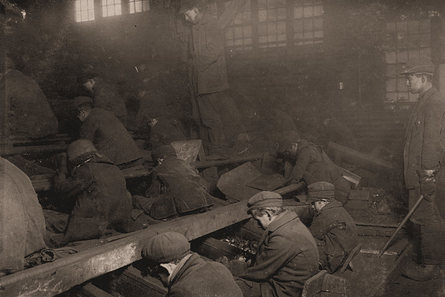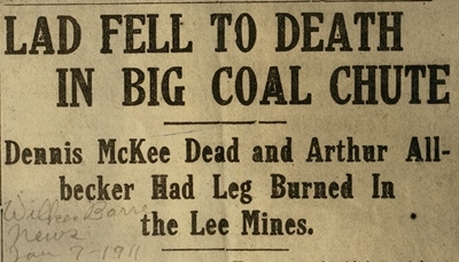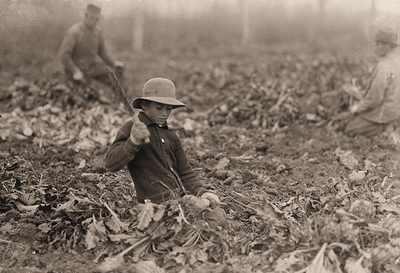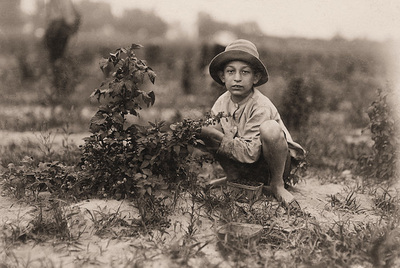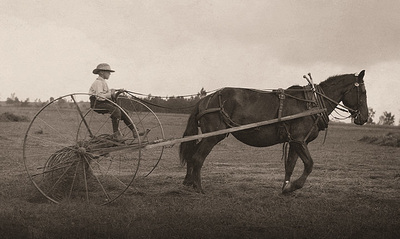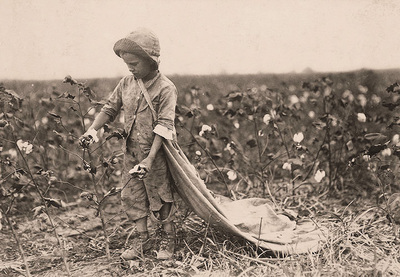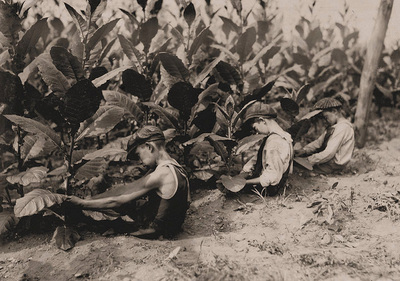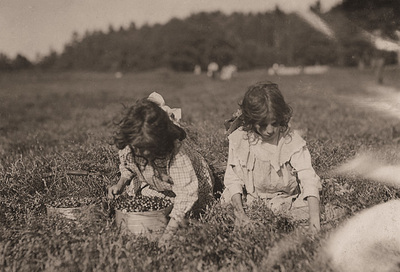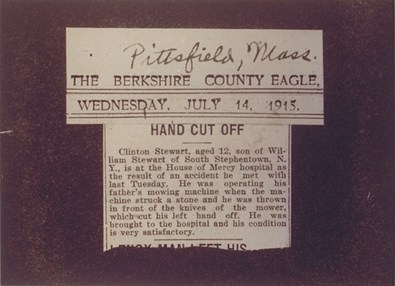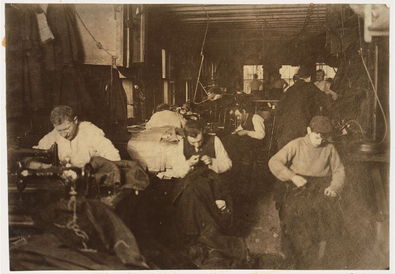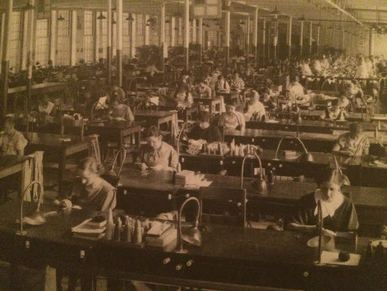Workplace Struggles
Spinners and Doffers in Mills
“When my machines get old and useless, I reject them and get new ones and these [children] are part of my machinery”
-New England Mill Owner [1858]
|
Young girls employed illegally as spinners worked for eleven to twelve hours a day mending breaks in the threads of the machines.
"I had to clean fallers, which, like teeth, chopped down on one's hand, unless great precautions were used" |
|
If a bobbin ran out of thread, a boy called a “doffer” would rush to replace it. The accident rate for children was twice the rate for adults.
"A twelve year old doffer boy fell into the spinning machine and the unprotected gearing tore out two of his fingers. 'We don't have any accidents in this mill,' the overseer told me. 'Once in a while a finger is mashed or a foot, but it don't amount to anything'" |
Newsies and Salesmen
|
Children working the streets were often seen as enterprising youngsters starting on the road to success.
"He is the youngest demonstrator in America. Has been doing it for several years from San Francisco to New York. We stay a month or six weeks in a place. He works at it off and on" -Father of Tommie Nooman [1911] |
|
However, roaming the streets unsupervised resulted in many young "newsies" adopting bad habits.
"I grew up on a pool table, I lived on the streets practically all day, days and nights both. We used to sneak into the burlesque houses or the all-night places on West Madison street and sleep there" |
Breaker and Trapper Boys in the Mines
Large numbers of young boys were employed in coal breakers outside mines to pick out pieces of slate from the coal.
"The fingers of breaker boys were often bloody, the flesh shredded, from spending long hours picking out sharp-edged slate from a moving conveyor belt. This condition was called red top"
-Peter Roberts, author of Anthracite Coal Communities [1904]
"The dust was so dense at times as to obscure the view and penetrated the utmost recesses of the boys' lungs. A kind of slave-driver sometimes stands over the boys, prodding or kicking them into obedience" -Lewis Hine [1911]
"Falling into a chute at the Chauncey colliery of the George S. Lee Coal Company at Avondale this afternoon, Dennis McKee, aged fifteen of West Nanticoke was smothered to death and Arthur Allbecker, aged fifteen had both of his legs burned and injured...Both boys were employed as breaker boys, and going too close to their chutes, fell in...When taken out, McKee was found to be dead. His remains were removed to his home at West Nanticoke. Allbecker will recover" [1911] |
The work performed by the breaker boys was extremely hazardous, often resulting in a loss of limbs and fatal lung diseases.
Working in Agriculture
"Children as young as five were expected to work in agriculture, usually picking or hulling berries. During the first decade of the 1900s, up to fifteen hundred children were employed to harvest one berry crop...because most of these small immigrant children did not speak English, they did not know their boss was cheating them, just as they did not know he would regularly underpay them for their work" -Historian Rebecca Valentine [2007]
click to enlarge and hover to view captions [Library of Congress NCLC Collection]
"Clinton Stewart, aged 12, son of William Stewart of South Stephentown, N.Y., is at the House of Mercy hospital as the result of an accident he met with last Tuesday. He was operating his father's mowing machine when the machine struck a stone and he was thrown in front of the knives of the mower, which cut his left hand off. He was brought to the hospital and his condition is very satisfactory" [1915] |
Sweatshop Workers
"As each girl completed her part the garment was passed on to the next girl by Levinson [the shop boss] who was always walking back and forth urging us on. Should a girl lag behind, he would prod her, sometimes pulling on the garment to hurry it on to another worker. At the end of each week the girl who had turned out the least work was dropped from the payroll. Knowledge of this had the effect of keeping the girls working like mad" |
|
“The corner of the [sweat]shop would resemble a kindergarten because we were young...it was a world of greed; the human being didn't mean anything. The hours were from 7:30 in the morning to 6:30 at night...we [sometimes] worked until nine o clock. No overtime pay, not even supper money” -Pauline Newman, Triangle Shirtwaist Factory worker [1901]
The harsh reality of working conditions for child laborers was largely unknown to most Americans. Due to this, there was no support from the public for labor to be regulated.
|
Thesis:
The leadership of the National Child Labor Committee piloted the social reform movement against the exploitation of children. By harnessing the power of propaganda to influence public opinion, the NCLC changed society’s perception, thus allowing for the passage of national legislation prohibiting the labor of children. The legacy of the NCLC lies not only in ending child labor, but also in establishing a precedent for future federal regulation of labor. |
Niharika Boinpally and Divya Pakianathan
Senior Group Website Word Count (Student Composed): 1166 Process Paper Word Count: 484 |
